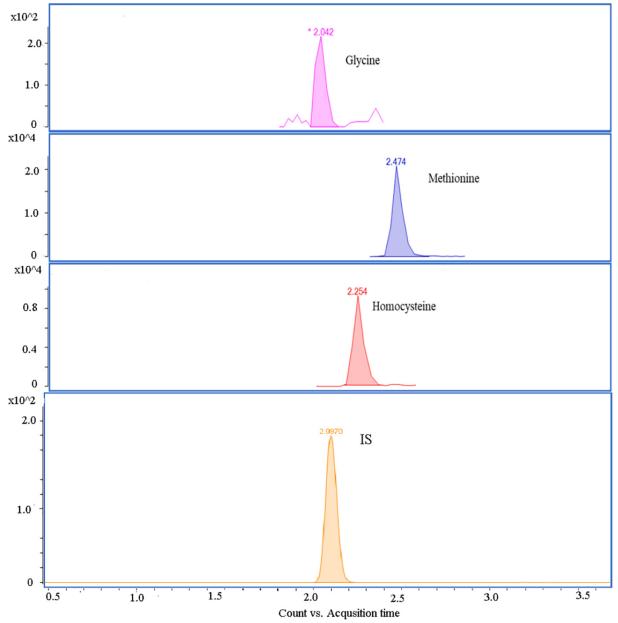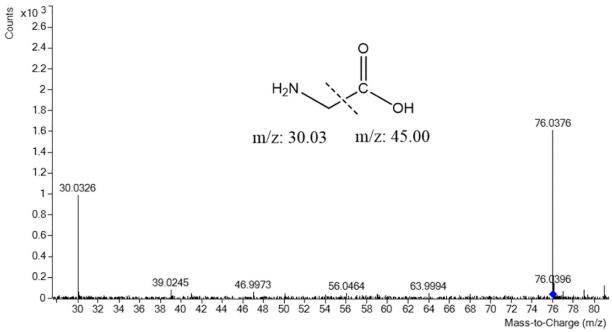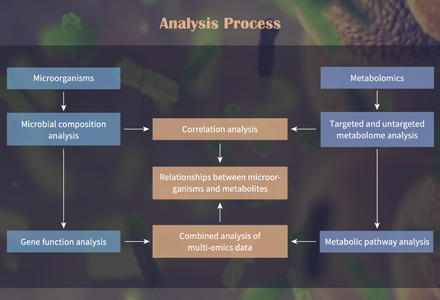Glycine Analysis Service
Submit Your Inquiry- Service Details
- Case Study
Introduction of Glycine
Glycine is associated with the synthesis of proteins and physiologically active molecules related to many important metabolisms. Glycine is involved in signaling as a neurotransmitter in the central nervous system and plays an important role in immunomodulation, cytoprotection, protection against ischemia-reperfusion injury, reduction of free radical production, reduction of shock injury, and prevention of alcoholic liver disease. In terms of biotransformation, glycine is involved in the synthesis of many important nitrogenous substances, such as purine bases, porphyrin rings of heme and cytochromes, creatine, glutathione and glycocholic acid, in addition to constituting proteins. In addition, glycine can also react with a large number of endogenous substances and drugs to affect the metabolic excretion of related drugs and play a detoxifying role.
Glycine the most commonly used amino acid in plant uptake studies. It is considered as an important source of plant nitrogen source due to its low relative molecular mass, low carbon to nitrogen ratio, and fast diffusion rate in the soil.
In order to better explore the functional role of glycine in life activities, Creative Proteomics has UPLC-MS/MS analysis system to provide you with glycine content testing service and metabolite analysis during glycine metabolism to accelerate your research progress.
Applications of Glycine Analysis
- Understand the role of glycine in plant cell metabolism
- Regulate the growth and immunity of plants
- Predict the condition of plant protein synthesis
- Improve plant production
- Assess plant quality and phenotyping
Advantages of Our Glycine Analysis Service
Analytical Workflow for Glycine Analysis
Our newly developed sample preprocessing method provides efficiency, recovery rates consistently exceeding 85%, and environmental protection. Sample preprocessing at Creative Proteomics complies with in-house standard operation procedures (SOP), maximizing homogeneity between samples.
 Figure 1. Glycine analysis service workflow.
Figure 1. Glycine analysis service workflow.
Quantification methods: external reference method or isotope-labeled internal standard method
Mode: MRM, capable of simultaneously detecting more than 1000 MRM ion pairs
Precision: ≤10-9 g
Positive/Negative polarity switching time: ≤20 ms, allowing for the acquisition of Q1/Q3 MRM transition mass spectra in both ionization modes from a single LC-MS/MS run.
Our Glycine Analysis Content Includes:
Quantitative Glycine Content Testing: Accurate measurement of glycine levels using state-of-the-art UPLC-MS/MS analysis systems. Gain insights into the concentration of this crucial amino acid in your samples.
Metabolite Analysis During Glycine Metabolism: Explore the dynamic metabolite profile during glycine metabolism. Our advanced analytical techniques provide a detailed view of the metabolic pathways and transformations involved.
Functional Role Exploration: Uncover the multifaceted role of glycine in life activities, including its participation in immunomodulation, cytoprotection, and detoxification processes. Gain a deeper understanding of how glycine influences various physiological functions.
Biotransformation Insights: Investigate glycine's involvement in the synthesis of nitrogenous substances such as purine bases, porphyrin rings, creatine, glutathione, and glycocholic acid. Understand its contribution to the formation of essential biological molecules.
Plant Uptake Studies: As the most commonly studied amino acid in plant uptake research, our services provide valuable data on glycine as a nitrogen source. Benefit from its low molecular mass, optimal carbon to nitrogen ratio, and rapid soil diffusion rate.
Detoxification and Drug Metabolism Impact: Examine how glycine interacts with endogenous substances and drugs, influencing the metabolic excretion of related compounds. Gain insights into its detoxifying role in biological systems.
Sample Requirements of Glycine Analysis
| Sample Type | Sample Volume | Storage Conditions | Preparation Guidelines |
|---|---|---|---|
| Serum/Plasma | 100-500 µL | -80°C for long-term storage | Avoid repeated freeze-thaw cycles |
| Urine | 1-2 mL | -20°C for short-term storage | Centrifuge to remove debris before analysis |
| Tissue (Homogenized) | 10-50 mg | -80°C for long-term storage | Homogenize in appropriate buffer using a tissue homogenizer |
| Cell Culture Supernatant | 0.5-1 mL | -80°C for long-term storage | Centrifuge to remove cells and debris |
| Plant Material | 50-100 mg | -80°C for long-term storage | Freeze-dry or grind to a fine powder |
Deliverables of Glycine Analysis
- Experimental procedure
- Parameters of UPLC and MS
- Raw data, chromatograms and mass spectra
- Metabolites quantification data
- Custom analysis report
With rich experience in amino acids analysis, we can provide accurate, efficient, and cost-effective glycine qualitative and quantitative analysis services. The flexibility of our techniques can cope with different samples and provide satisfactory results.
References
- Schegg KM, Denslow ND, Andersen TT, Bao Y, Cohen SA, Mahrenholz AM, Mann K: Quantitation and identification of proteins by amino acid analysis: ABRF-96AAA collaborative trial. In: Techniques in Protein Chemistry. Edited by Marshak DR, vol. 8: Academic Press; 1997: 207-216.
- Wang X, Tang D, Huang D: Proteomic analysis of pakchoi leaves and roots under glycine–nitrogen conditions. PLANT PHYSIOL BIOCH 2014, 75:96-104.
Case: Simultaneous Determination of Glycine, Homocysteine, and Methionine in Human Plasma and Urine Using LC-QTOF-MS/MS
Background
The importance of early disease diagnosis and treatment underscores the exploration of biomarkers. Amino acids, like glycine, serve as valuable indicators of biological conditions, playing a pivotal role in disease monitoring. Particularly significant in childhood brain tumors, glycine emerges as a potential biomarker. This study is dedicated to formulating an analytical method for the concurrent determination of glycine, homocysteine, and methionine, recognizing their roles in structural and functional processes within the human body.
Samples
Human plasma and urine samples, donated by healthy volunteers, were pooled and filtered before use. The study aimed to assess these biological samples for the presence of glycine, homocysteine, and methionine.
Technical Methods
The research utilized liquid chromatography–quadrupole-time-of-flight-tandem mass spectrometry (LC-QTOF-MS/MS) to accurately determine target compounds. Chromatographic separation employed an Intrada column and a gradient elution system with ammonium formate buffer and methanol. Mass spectrometry results, particularly the fragmentation patterns of glycine, homocysteine, and methionine, were presented. The method's analytical performance underwent assessment for linearity, sensitivity, precision, and accuracy. Matrix effects, a common LC-MS issue, were addressed, and a matrix matching strategy was implemented to counteract ionization suppression. The study also incorporated an internal standard (glycine-d5) for recovery studies.
Results
The optimized method demonstrated high sensitivity and accuracy, with LOD and LOQ values ranging from 0.017 μg/mL to 0.73 μg/mL. The method was successfully applied to biological samples, showing satisfactory accuracy (84.2%–103.7%) and recovery (91.3%–106.8%) in plasma and urine samples. The study concludes that the proposed method is reliable for simultaneous determination of glycine, homocysteine, and methionine, offering potential applications in biomarker studies.
 Extracted ion chromatograms of glycine, methionine and homocysteine (10.0 mg/L of mixed standard solution).
Extracted ion chromatograms of glycine, methionine and homocysteine (10.0 mg/L of mixed standard solution).
 The molecular ion fragmentation of glycine (CE: 10 V).
The molecular ion fragmentation of glycine (CE: 10 V).
Reference
- Şaylan, Meltem, et al. "An accurate and sensitive analytical method for the simultaneous determination of glycine, methionine and homocysteine in biological matrices by matrix matching strategy and LC–quadrupole-time-of-flight-MS/MS." Spectrochimica Acta Part A: Molecular and Biomolecular Spectroscopy 239 (2020): 118394.







